Table of Contents[Hide][Show]
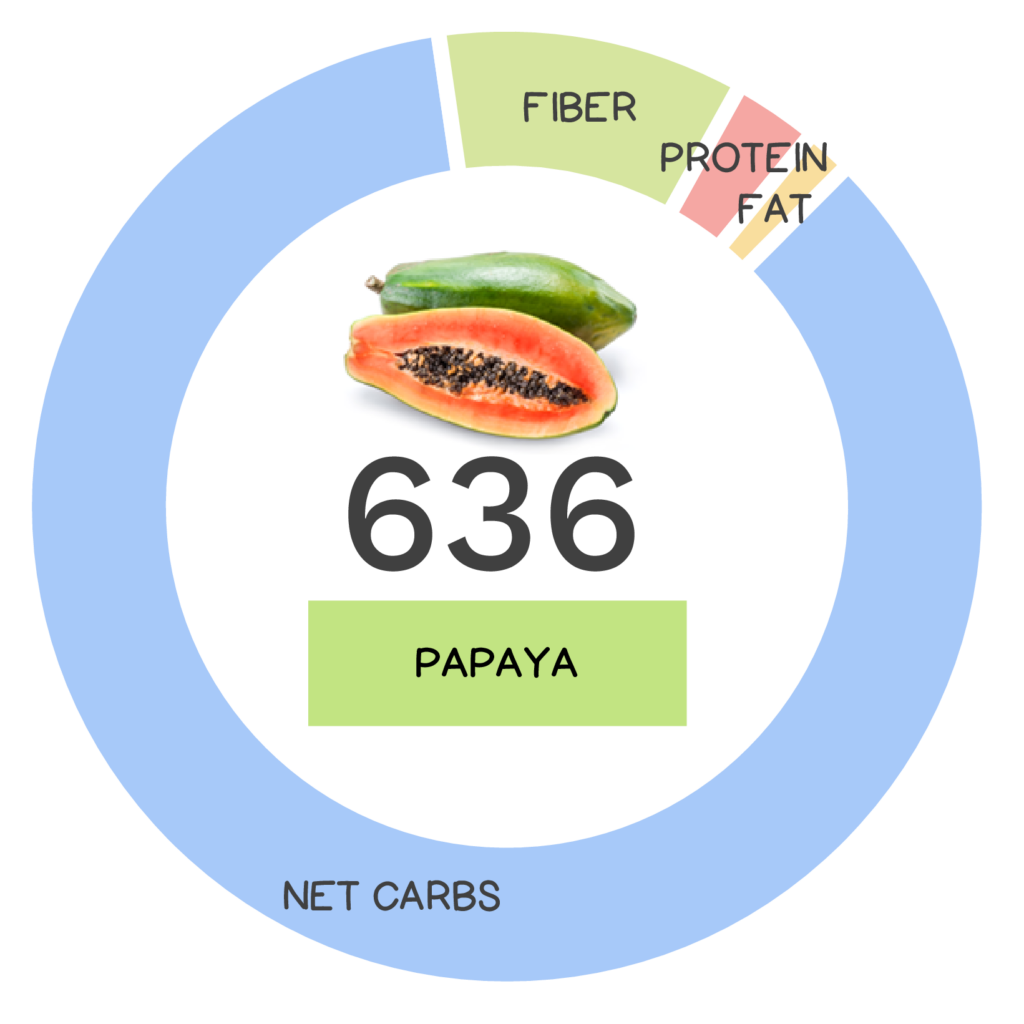
Papaya – a popular tropical fruit with creamy, buttery pink, orange or yellow flesh and a delicate sweet taste. Not only is the flesh of the ripe fruit enjoyed, but unripe “green papaya” is also popular in many cuisines. Remarkably, all parts of the plant can be eaten including leaves (prepared like spinach), seeds (which have a sharp, spicy taste) and even flower buds. Talk about versatile!
Technically, papaya is a large berry which grows on trees!
Papayas (Carica papaya) originated in Central America, southern Mexico and the northern part of South America. Technically the fruit is a large berry which grows on trees, though we don’t think of it that way. Most of us may not realize, but this fruit was nearly wiped out by a pathogen called the papaya ringspot virus that struck nearly all papaya-growing areas by the 1990s. Fortunately, scientists were able to develop papaya crops resistant to the virus through genetic modification and rescue this tasty fruit! Today, the papaya is an economically important crop and is cultivated in over 50 different countries around the world. Like most tropical fruits, the majority of production comes from low-income developing countries. Global production is led by India and is growing significantly in part due to increased demand from the US.
Papaya is a great source of glucosinolates, phytonutrients known for their anticancer properties, typically associated with cruciferous vegetables.
Interestingly, green papaya fruit is rich in papain, a protease enzyme which aids in protein digestion and is useful for tenderizing meat. This also means papaya is unsuitable for use in gelatin-based desserts because it will break apart proteins, preventing the gelatin from setting (turning your gelatin mold into a gelatin flop!).

Nutrivore Score for Papaya – 636
Papaya has a Nutrivore Score of 636, making it a high nutrient-dense food! Plus, it is a low-calorie-density food; the calorie count of papaya is 62 calories per cup!
Per serving, papaya is a best source (>50% daily value) of glucosinolates and vitamin C; an excellent source (20-50% daily value) of carotenoids and polyphenols; and a good source (10-20% daily value) of vitamin B9 (folate).
Ditch Diets. Embrace Nutrients. Start with this FREE Guide.
Sign up for the free Nutrivore Newsletter, your weekly, science-backed guide to improving health through nutrient-rich foods — without dieting harder —and get the Beginner’s Guide to Nutrivore delivered straight to your inbox!

Papaya Nutrition Facts
One serving of papaya is standardized to 1 cup, 1 ” pieces, or about 145 grams (1.6 ounces). For reference, one small papaya weighs roughly 157 grams, while one large fruit weighs on average 781 grams!
Papaya Nutrition Facts Per Serving
| Papaya, raw | Nutrivore Score: 636 | Nutrient Density: High |
|---|---|---|
| Serving Size: 1 cup, 1 ” pieces (145 grams) | Protein: 0.7 grams | Net Carbohydrates: 20.3 grams |
| Calories: 62 | Total Fat: 0.4 grams | Dietary Fiber: 2.5 grams |
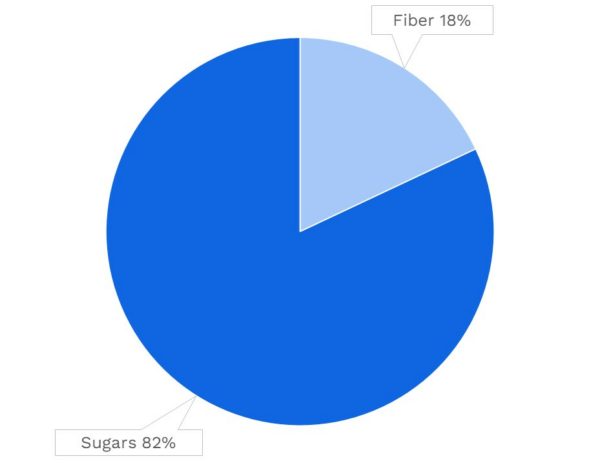
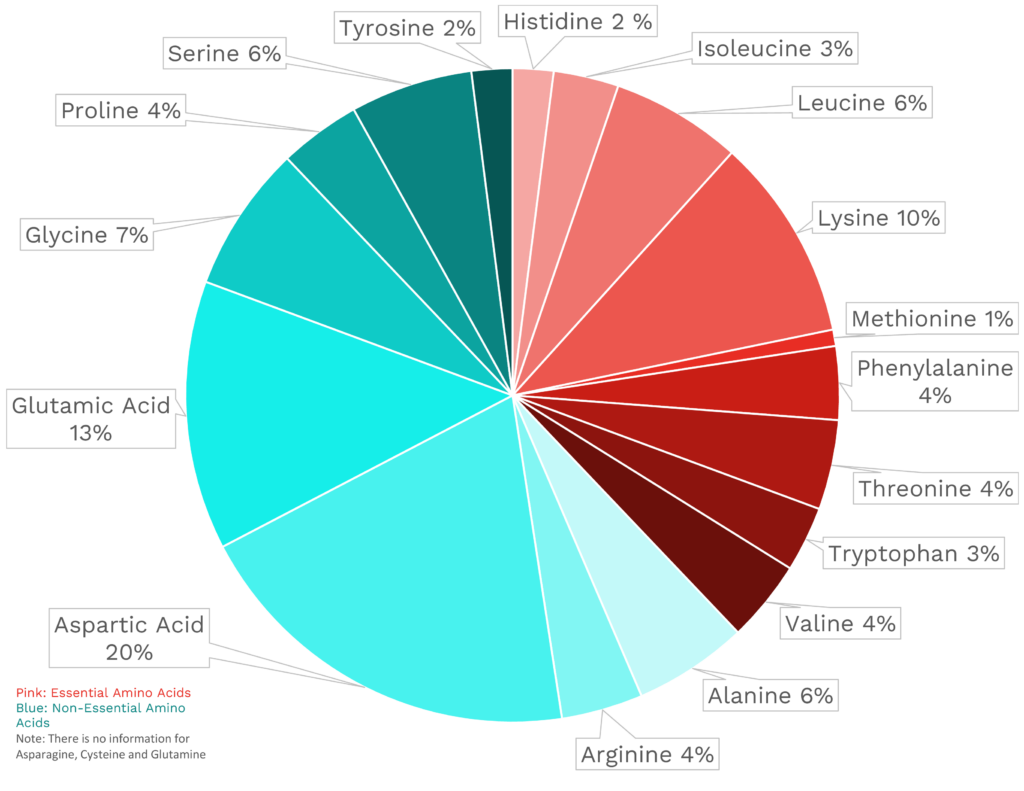
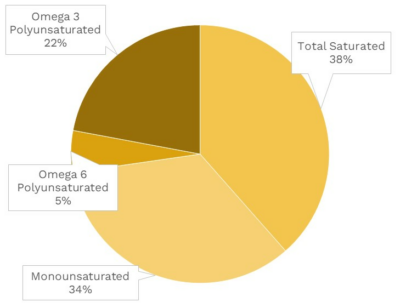
| VITAMINS | ||
|---|---|---|
| Vitamin A | 68.2 μg RAE | 8% DV |
| Vitamin B1 (Thiamin) | 33.4 μg | 3% DV |
| Vitamin B2 (Riboflavin) | 39.2 μg | 3% DV |
| Vitamin B3 (Niacin) | 0.5 mg | 3% DV |
| Vitamin B5 (Pantothenic Acid) | 0.3 mg | 6% DV |
| Vitamin B6 (Pyridoxine) | 55.1 μg | 3% DV |
| Vitamin B7 (Biotin) | 0.3 μg | 1% DV |
| Vitamin B9 (Folate) | 53.7 μg | 13% DV |
| Vitamin B12 (Cobalamin) | 0.0 μg | 0% DV |
| Vitamin C | 123.1 mg | 137% DV |
| Vitamin D (D2 + D3) | 0.0 μg | 0% DV |
| Vitamin E | 0.7 mg | 5% DV |
| Vitamin K | 3.8 μg | 3% DV |
| Choline | 8.8 mg | 2% DV |
| Myo-Inositol | 11.6 mg | ~ |
| CoQ10 | ~ | ~ |
| FUNCTIONAL FATS | ||
|---|---|---|
| MUFA | 0.1 g | 1% DV |
| ALA | 68.2 mg | 4% DV |
| EPA + DHA | 0.0 mg | 0% DV |
| CLA | ~ | ~ |
| Linoleic Acid | 0.0 g | 0% DV |
| MCT’s | 0.0 g | ~ |
| MINERALS | ||
|---|---|---|
| Calcium | 29.0 mg | 2% DV |
| Copper | 65.3 μg | 7% DV |
| Iodine | ~ | ~ |
| Iron | 0.4 mg | 2% DV |
| Magnesium | 30.5 mg | 7% DV |
| Manganese | 58.0 μg | 3% DV |
| Phosphorus | 14.5 mg | 1% DV |
| Potassium | 263.9 mg | 6% DV |
| Selenium | 0.9 μg | 2% DV |
| Sodium | 11.6 mg | 1% DV |
| Zinc | 0.1 mg | 1% DV |
| PHYTONUTRIENTS | ||
|---|---|---|
| Carotenoids | 4033.9 μg | ~ |
| Polyphenols | 230.6 mg | ~ |
| Phytosterols | 24.5 mg | ~ |
| Glucosinolates | 53.7 mg | ~ |
| Thiosulfinates | ~ | ~ |
| Betalains | ~ | ~ |
| AMINO ACIDS & PEPTIDES | ||
|---|---|---|
| Taurine | ~ | ~ |
| Ergothioneine | ~ | ~ |

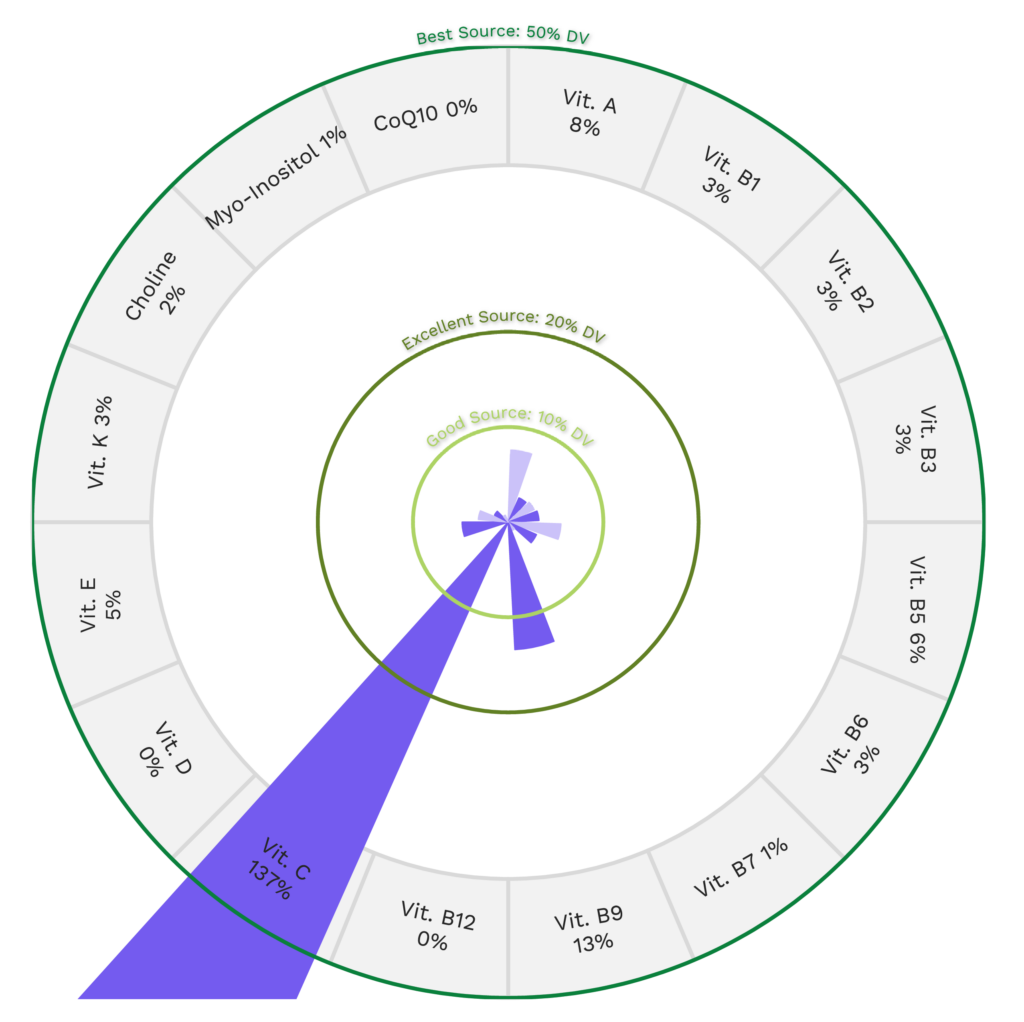
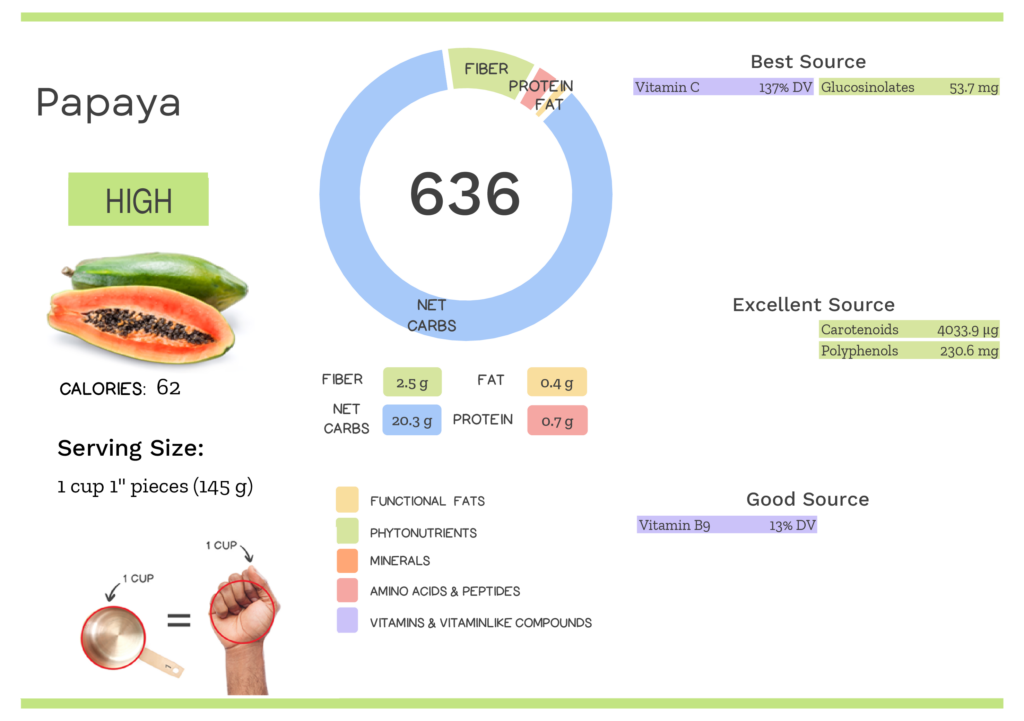
Surprised that papaya is THAT nutritious? Maybe your friends will be too!
Health Benefits of Papaya Nutrients
Let’s take a closer look at all of the best and excellent source of nutrients found in a 1-cup serving of papaya and see how they benefit our health.
Papaya Provides 137% DV Vitamin C
Papaya is a fantastic source of vitamin C, providing 137% of the daily value per 1-cup serving!
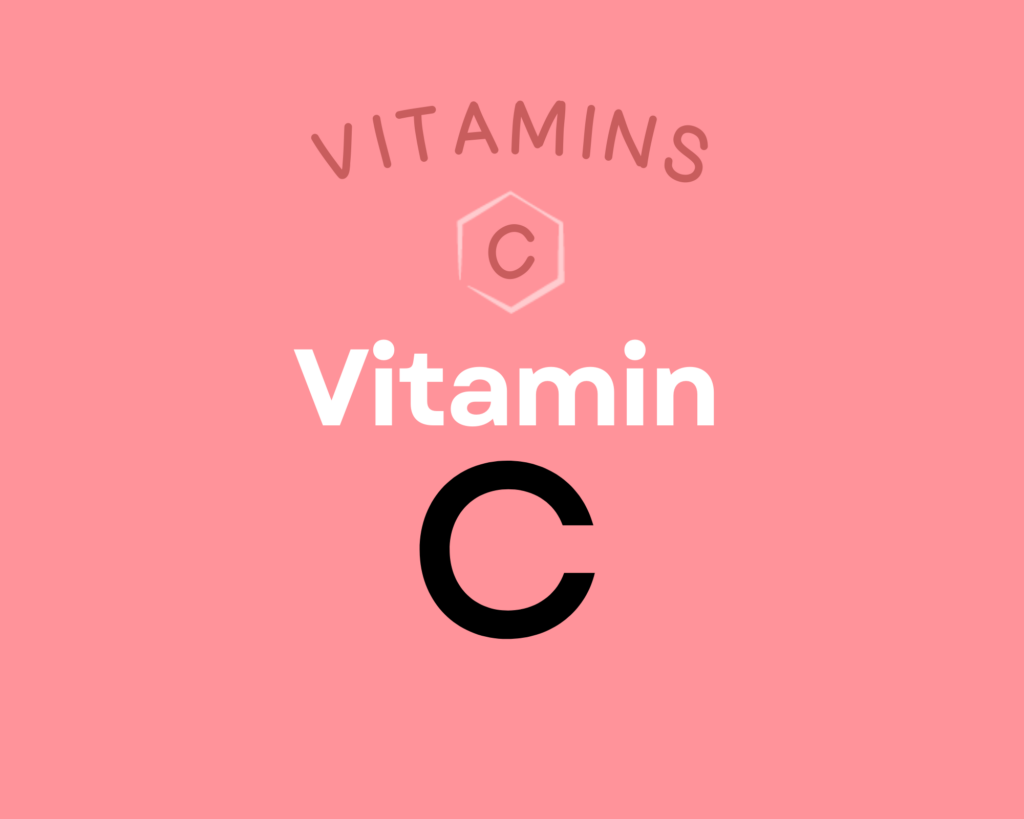
Vitamin C is a water-soluble vitamin that has powerful antioxidant properties (meaning it can help combat oxidative damage from free radicals and reactive oxygen species) and that serves as an enzyme cofactor (meaning it’s needed for enzymes to do their job, for example vitamin C is necessary for collagen synthesis, which is essential for bones, joints, teeth, blood vessels, skin and eyes) and playing important roles in immune system and skin health. Higher intakes of vitamin C are linked to reduced risk of heart disease, some forms of cancer, type 2 diabetes, cataracts, age-related macular degeneration, and gout. Vitamin C can also help regulate the stress response and reduce anxiety, and there’s preliminary evidence that it may also help prevent Alzheimer’s disease. Learn more about vitamin C here.
Papaya Provides 53.7 mg of Glucosinolates
Papaya is a fantastic source of glucosinolates, providing 53.7 mg of glucosinolates per 1-cup serving!
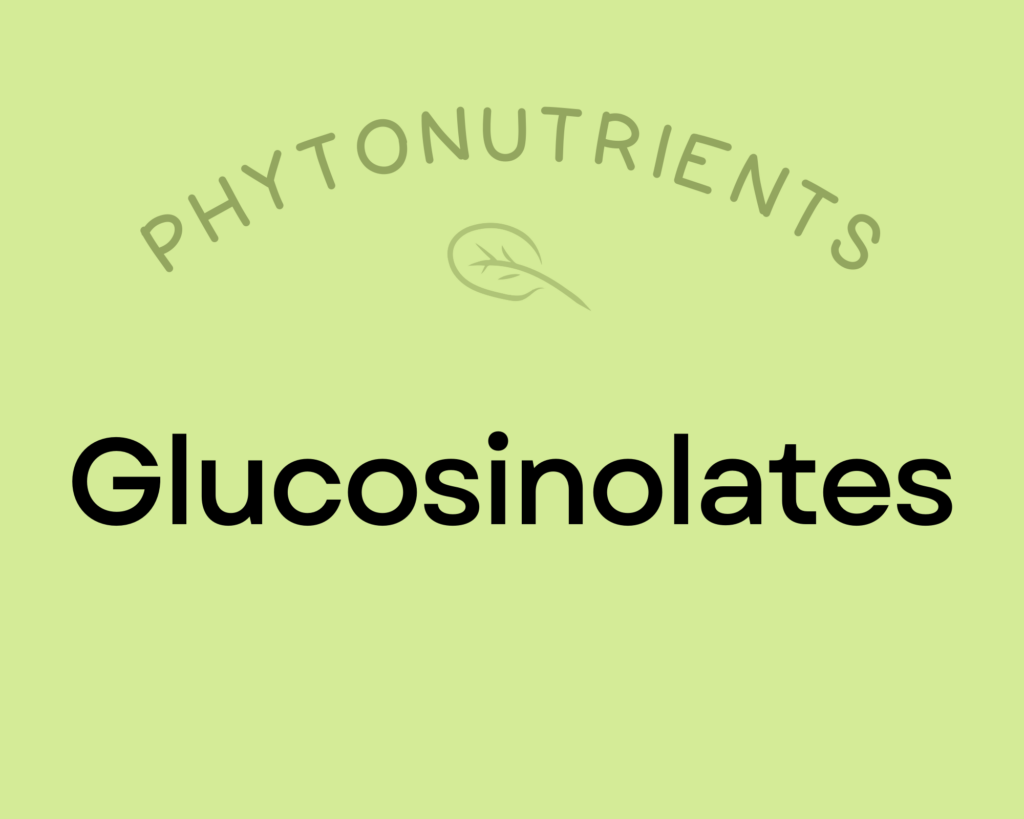
Glucosinolates are well-studied sulfur-containing compounds which break down into bioactive isothiocyanates and indoles when vegetables are damaged (via chewing, cutting, or other processing).
Isothiocyanates (like sulforaphane) are absolute rock stars as far as human health is concerned! Research spanning human epidemiology, animal models, and in vitro experiments show that dietary isothiocyanates are inversely associated with bladder cancer, lung cancer, colon cancer, breast cancer, and pancreatic cancer; some evidence also suggests they may be able to improve ventricular function following heart attacks.
Indoles also have powerful cancer prevention benefits through multiple mechanisms that include modulation of phases I and II detoxification enzymes, regulation of cell cycle arrest, control of cell growth, induction of apoptosis, antioxidant activity, anti-angiogenic effects, and epigenetic regulation. Indole-3-carbinol breaks down into 3,3′-Diindolylmethane (DIM), which is known for its anti-inflammatory, immune system modulating, cancer prevention and estrogen metabolism benefits.
Learn more about glucosinolates here.
Papaya Provides 4033.9 μg of Carotenoids
Papaya is an excellent source of carotenoids, containing 4033.9 μg carotenoids per 1-cup serving!
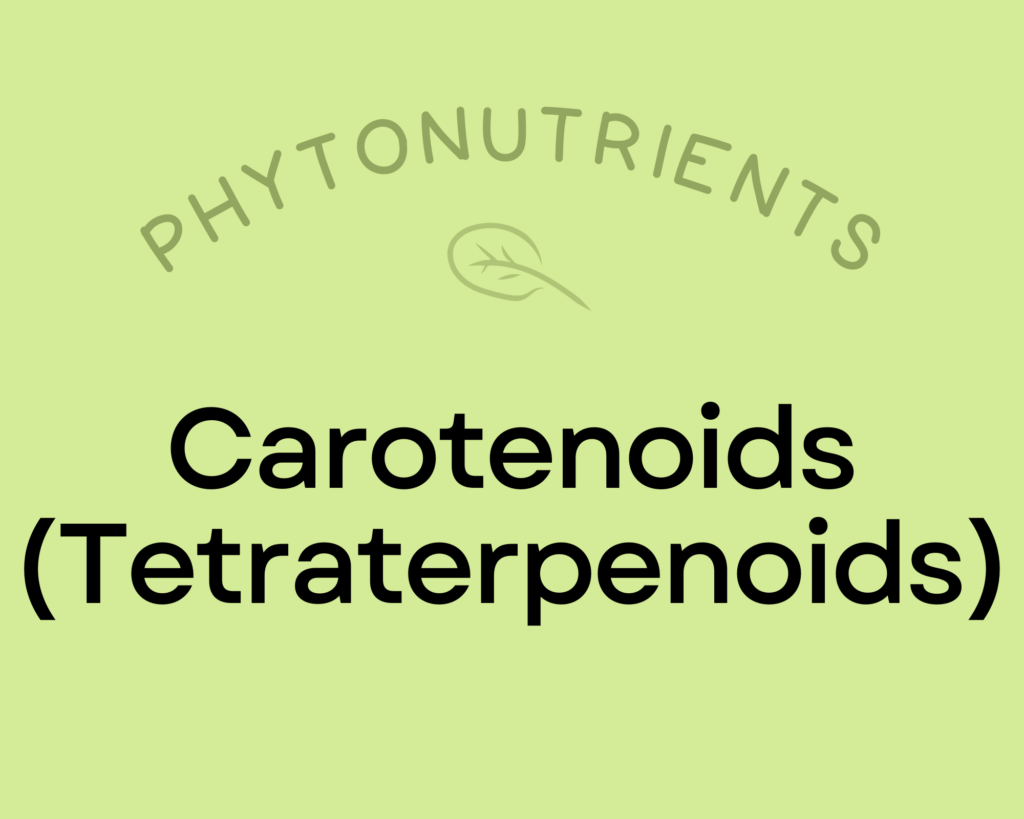
Carotenoids are a diverse group of phytonutrients that are responsible for giving fruits and vegetables vibrant red, orange, and yellow pigmentation. They were one of the earliest phytonutrients ever investigated by scientists (with research dating back to the 1800s!). Across studies, eating foods high in carotenoids appears to reduce the risk of head and neck cancers, supports vision health (particularly age-related eye diseases), may protect against metabolic syndrome and diabetes, and can reduce inflammation. Carotenoids have strong antioxidant properties, and help facilitate communication between cells by promoting the synthesis of connexin proteins, which create gap junctions in cell membranes that allow small molecules to be exchanged (which is part of how cells “talk” to each other!). Consuming carotenoids with fat significantly increases their absorption. Learn more about carotenoids here.
Papaya Provides 230.6 mg of Polyphenols
Papaya is also an excellent source of polyphenols, providing 230.6 mg polyphenols per 1-cup serving!
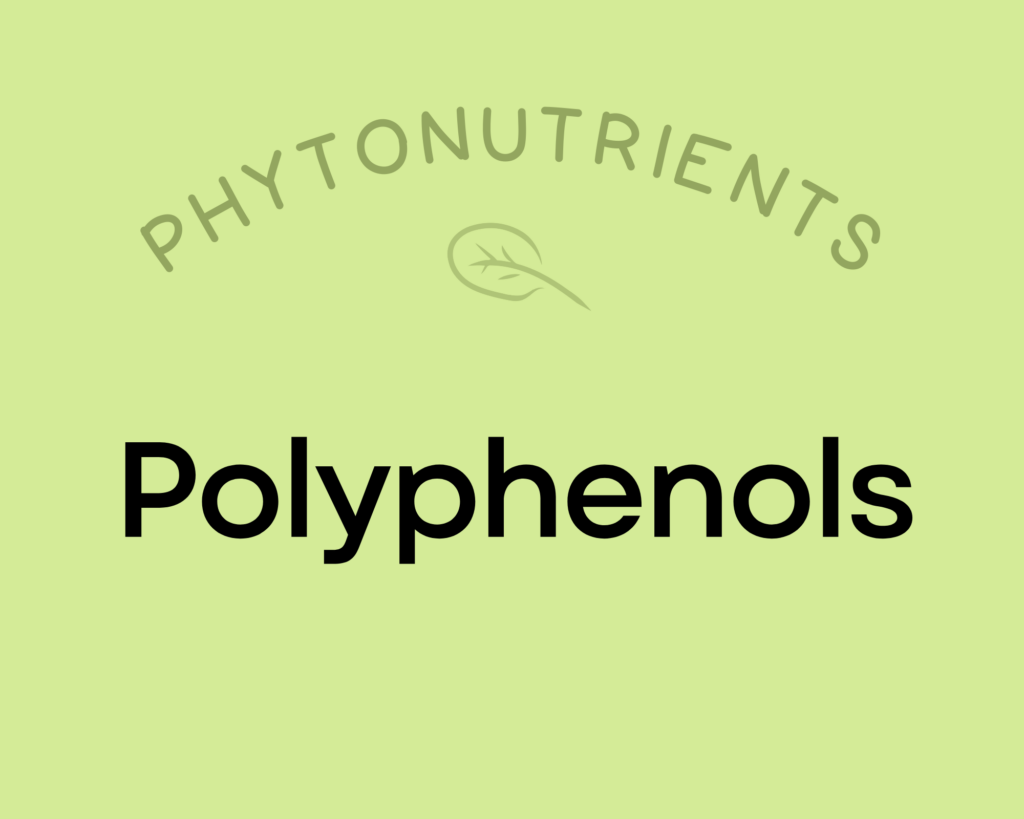
Polyphenols play a huge role in protecting against cancer, heart disease, diabetes, asthma, osteoporosis, neurodegenerative diseases, and other conditions associated with oxidative stress. In fact, a major reason foods like red wine and olive oil (as well as diets rich in both, such as the Mediterranean diet) show up as so beneficial may be due to their high polyphenol content! Along with chronic diseases, supplementing with polyphenols has been shown to protect against infections and reduce the signs of aging. Polyphenols exert their most potent effects by acting as antioxidants—preventing cellular damage by neutralizing hazardous oxygen radicals and improving cellular health as a result (which, in turn, benefits virtually every system in the body). As a result of their antioxidant properties, polyphenols also boost the immune system and protect against both chronic and acute diseases. In addition, polyphenols can help regulate enzyme function, stimulate cell receptors, modulate the functions of inflammatory cells (including T and B lymphocytes, macrophages, platelets, and natural killer cells), alter adhesion molecule expression, affect nerve cells and cardiac muscle cells, and exert antiviral effects. Learn more about polyphenols here.
Want to know the top 500 most nutrient-dense foods?
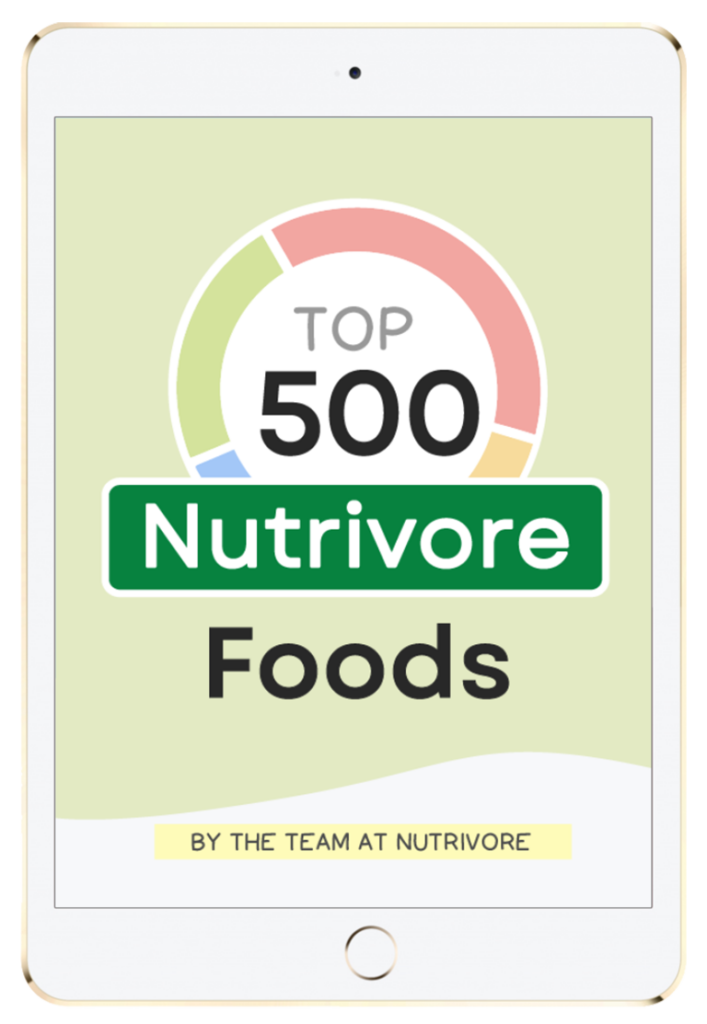
Top 500 Nutrivore Foods
The Top 500 Nutrivore Foods e-book is an amazing reference deck of the top 500 most nutrient-dense foods according to their Nutrivore Score. Think of it as the go-to resource for a super-nerd, to learn more and better understand which foods stand out, and why!
If you are looking for a quick-reference guide to help enhance your diet with nutrients, and dive into the details of your favorite foods, this book is your one-stop-shop!
Buy now for instant digital access.
How Much Papaya Should We Eat Per Day?
Vilified for its higher sugar content, tropical fruit sometimes gets a bad rap even though these tasty fruits provide plenty of health benefits!
Eating two or three servings of fruit per day is optimal from a health perspective. A 2017 systemic review and meta-analysis looked at how all-cause mortality was impacted by varying intakes of 12 different food groups: whole grains and cereals, refined grains and cereals, vegetables, fruits, nuts, legumes, eggs, dairy products, fish, red meat, processed meat, and sugar-sweetened beverages. This analysis revealed non-linear relationships between how much of a particular food group we eat and how it impacts our health. While the results revealed no upper limit to the benefits of vegetable intake, the sweet spot for fruit intake was 300 grams daily. Intakes of fruit over 400 grams per day were not as beneficial as 300 grams, but the good news is that even intakes of 600 grams of fruits per day was superior to no fruit at all! This sweet spot for fruit intake translates to 2 to 3 servings of fruit daily.
And a 2018 review similarly concluded that two to three servings of fruit daily was optimal for reducing risk of cardiovascular disease, type 2 diabetes, obesity, chronic obstructive pulmonary disease, chronic constipation, and inflammatory bowel disease.
Fruit makes a convenient snack, a healthy dessert, a whimsical addition to salads, and a sophisticated flavoring agent in the form of salsas, jams, and chutneys. A serving is standardized to 1 cup chopped for raw vegetables and fruits (typically translates to 1/2 cup to 2/3 cup once cooked). Learn more in Importance of Vegetables and Fruit
But remember, it’s always best to mix up the fruits and veggies you eat day to day (aiming for a wide variety of different vegetables and fruits throughout the week), and papaya definitely has a place at the table.
Easily track your servings of Nutrivore Foundational Foods!

The Nutrivore Weekly Serving Matrix
The Nutrivore Weekly Serving Matrix digital resource is an easy-to-use and flexible weekly checklist designed to help you maximize nutrient-density and meet serving suggestions of Nutrivore foundational foods, all without having to weigh or measure your foods!
Includes a 22-page instructional guide and downloadable interactive guides.
Buy now for instant digital access.
Citations
Expand to see all scientific references for this article.
Clements RS Jr, Darnell B. Myo-inositol content of common foods: development of a high-myo-inositol diet. Am J Clin Nutr. 1980 Sep;33(9):1954-67. doi: 10.1093/ajcn/33.9.1954. PMID: 7416064.
Gómez-Maqueo A, Escobedo-Avellaneda Z, Welti-Chanes J. Phenolic Compounds in Mesoamerican Fruits-Characterization, Health Potential and Processing with Innovative Technologies. Int J Mol Sci. 2020 Nov 7;21(21):8357. doi: 10.3390/ijms21218357. PMID: 33171785; PMCID: PMC7664671.
Han JH, Yang YX, Feng MY. Contents of phytosterols in vegetables and fruits commonly consumed in China. Biomed Environ Sci. 2008 Dec;21(6):449-53. doi: 10.1016/S0895-3988(09)60001-5. PMID: 19263798.
Possenti, M, Baima S, Raffo A, Durazzo A, Giusti AM, Natella F. Glucosinolates in Food. Glucosinolates. 2016. 1-46. doi: 10.1007/978-3-319-26479-0_4-1.
Septembre-Malaterre A, Stanislas G, Douraguia E, Gonthier MP. Evaluation of nutritional and antioxidant properties of the tropical fruits banana, litchi, mango, papaya, passion fruit and pineapple cultivated in Réunion French Island. Food Chem. 2016 Dec 1;212:225-33. doi: 10.1016/j.foodchem.2016.05.147. Epub 2016 May 25. PMID: 27374527.
USDA Food Central Database: Papayas, raw
Watanabe T, Kioka M, Fukushima A, Morimoto M, Sawamura H. Biotin content table of select foods and biotin intake in Japanese. Int J Anal Bio-Sci. 2014. Vol 2(4):109-125.


